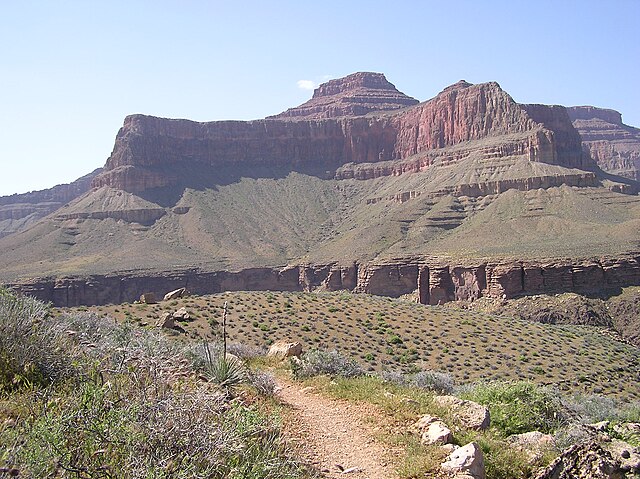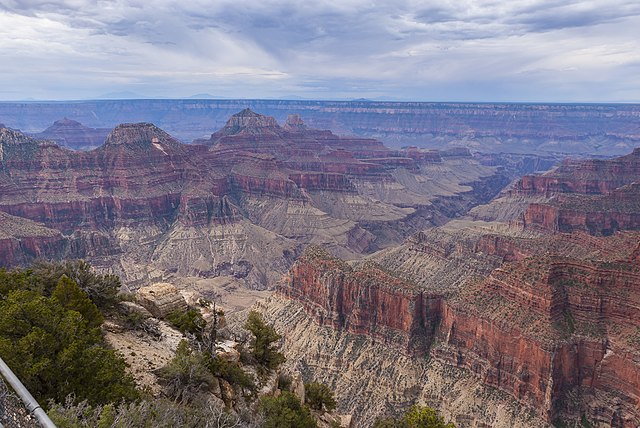The Muav Limestone is a Cambrian geologic formation within the 5-member Tonto Group. It is a thin-bedded, gray, medium to fine-grained, mottled dolomite; coarse- to medium-grained, grayish-white, sandy dolomite and grayish-white, mottled, fine-grained limestone. It also contains beds of shale and intraformational conglomerate. The beds of the Muav Limestone are either structureless or exhibit horizontally laminations and cross-stratification. The Muav Limestone forms cliffs or small ledges that weather a dark gray or rusty-orange color. These cliffs or small ledges directly overlie the sloping surfaces of the Bright Angel Shale. The thickness of this formation decreases eastward from 250 feet (76 m) in the western Grand Canyon to 45 feet (14 m) in the eastern Grand Canyon. To the west in southern Nevada, its thickness increases to 830 feet (250 m) in the Frenchman Mountain region.
representative sequence of Redwall Limestone, Temple Butte Formation, and Muav Limestone, in Grand Canyon
Muav Limestone cliff example, below Redwall Limestone cliff, on the North Kaibab Trail (closeup photos, often show purple erosion debris)(expandable photo)
(view due-north, northeast, from Bright Angel Trail, (South Rim section) – View of south-draining Bright Angel Canyon, containing in its lowest section with the Tapeats Sandstone, upon the Granite Gorge, the cliffs of gray-brown Muav Limestone (25% at base of Redwall Limestone), laid upon the slope-forming & greenish Bright Angel Shale. (The trail also descends/ascends through units on the South Rim, at near photo view.)
View to Sumner Butte, Redwall Limestone peak & vertical cliff, sitting on Muav Limestone
The Tonto Group is a name for an assemblage of related sedimentary strata, collectively known by geologists as a Group, that comprises the basal sequence Paleozoic strata exposed in the sides of the Grand Canyon. As currently defined, the Tonto groups consists of the Sixtymile Formation, Tapeats Sandstone, Bright Angel Shale, Muav Limestone, and Frenchman Mountain Dolostone. Historically, it included only the Tapeats Sandstone, Bright Angel Shale, and Muav Limestone. Because these units are defined by lithology and three of them interfinger and intergrade laterally, they lack the simple layer cake geology as they are typically portrayed as having and geological mapping of them is complicated.

Muav Limestone-(broader-based gray cliff supporting tall-reddish Redwall Limestone cliff) and Bright Angel Shale-(greenish & extensive slope-former), resting on Tapeats Sandstone-(short, dark vertical cliff on gorge rim) and the Tonto Platform, inner canyon, Granite Gorge (the two units are easily seen below the red-stained Redwall Limestone (~550 ft thick))
View of Tower of Set peak and sub-unit cliff section from Tonto Trail, Granite Gorge, north of Mohave Point, Grand Canyon Village, South Rim. The peak is behind and separated from a cliff unit (with small prominence), in front-(photo center, right, Tower of Set (peak) to its left). Vertical erosion in cliff of Redwall Limestone, upon horizontal Muav Limestone cliff. The Tapeats Sandstone sits in foreground on Granite Gorge, and is seen as thinly-bedded. The
close-up and far views of the Tonto Group formations. Note in far view the cliff-run of the Tapeats Sandstone cliff below the (whitish)-greenish Bright Angel Shale-(often dull-greenish, but even yellowish in northeast Grand Canyon).






